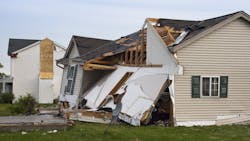Growing Climate Risks Continue to Weaken Home Insurance Affordability
With growing economic concerns and an increase in severe weather events, the home insurance market has faced a rough few years. A recent report from digital insurance platform Matic shows that insurance rate growth has moderated recently, but even so, substantial rises over the past few years have eroded any affordability that could have come from this stagnation. Additionally, as climate events and general uncertainty surrounding the economy persist, it’s unclear if this trend will hold in the long-term.
Insurance premiums have seen substantial growth over the last few years
According to the report, the average premium for new homeowners insurance policies currently stands at $1,966, which is a 9.3% increase from 2024. Premiums have been rising for quite some time. While rising over 9% in 2024, premiums rose even further the prior year. From 2023 to 2024, they rose by 18.8%, and from 2022 to 2023, they rose by 11.6%.
This rate of growth is a stark contrast from the typical 3% to 5% rate increases seen in years prior. Because of this shift, a growing number of people are finding that home insurance is either limiting their ability to purchase a home or is causing difficulty in maintaining their current property. Additionally, some homeowners report that over half of their monthly housing payments are now going toward insurance and taxes.
Climate change is the main driver of unaffordability in the homeowners insurance market
Insurance costs are climbing mainly due to climate-related disasters, which are now growing across the U.S. Insurance coverage issues have been a concern of homeowners in coastal markets for several years, but these concerns are now spreading inland as tornadoes become a bigger risk.
Severe storms in the central U.S. now account for about 70% of global insured losses, pushing up premiums even in areas previously seen as low-risk. Tornado activity, once centered in the plains, is shifting east into the Southeast and Midwest due to climate change factors like rising heat, more moisture, and unstable air. This change makes it harder for insurers to predict risks since past data no longer reflects future patterns.
Beyond tornadoes, wildfires and floods are also driving up costs and reducing coverage options. Major 2025 events, including the Los Angeles wildfires and flooding in North Carolina and Texas, have reinforced the need for homeowners to secure broad coverage—especially flood insurance—to protect against growing climate threats.
Home insurance costs have been growing for quite some time
- Home Insurance Costs Soar by 40% in 6 Years: Home insurance rates have climbed by 40.4% since 2019.
- Home Insurance Costs Surge: Home insurance costs have grown substantantially across the U.S. over the past few years, but particularly in coastal states such as Florida. From 2020 to 2023, nine of the 15 counties that experienced the highest insurance rate increases were in Florida.
